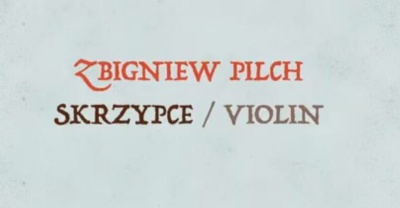Bach Romantique – premiere of a new album released by the National Forum of Music
Prague/Wroclav, August 4, 2024
On August 9, 2024, the new, double album of the National Forum of Music, Bach Romantique, will premiere.
This is the second solo album by violinist Zbigniew Pilch. It contains the complete six cello suites by Johann Sebastian Bach in the early Romantic arrangement for solo violin by Ferdinand David. The recording was made in the Main Hall of the National Forum of Music.
Recording Producers, editing, mastering: Andrzej Sasin, Aleksandra Nagórko (CD Accord).
The album is available online in the NFM Store: Choose items – Narodowe Forum Muzyki (nfm.wroclaw.pl) .
Title: Bach Romantique
Performer: Zbigniew Pilch – violin
Programme:
Johann Sebastian Bach (1685–1750)
Cello Suites arranged for solo violin (published ca. 1866) by Ferdinand David (1810-1873)
CD 1
Suite No. 3 in G major BWV 1009 [23’10]
[ 1 ] Prélude: Allegro 3’56
[ 2 ] Allemande: Moderato 3’57
[ 3 ] Corrente: Allegro 3’51
[ 4 ] Sarabande: Lento 3’55
[ 5 ] Loure I: Allegro & Loure II 3’42
[ 6 ] Gigue: Vivace 3’47
Suite No. 4 in B flat major BWV 1010 [25’02]
[ 7 ] Prélude: Allegro ma non troppo 3’57
[ 8 ] Allemande: Allegro 4’36
[ 9 ] Corrente: Allegro 4’00
[ 10 ] Sarabande: Lento 4’10
[ 11 ] Loure I: Allegro ma non troppo & Loure II 4’59
[ 12 ] Gigue: Allegro 3’18
Suite No. 5 in G minor BWV 1011 [27’16]
[ 13 ] Prélude: Adagio. Allegro 6’40
[ 14 ] Allemande: Moderato 5’46
[ 15 ] Corrente: Allegro 2’59
[ 16 ] Sarabande: Lento 4’07
[ 17 ] Gavotte I: Allegro & Gavotte II 5’20
[ 18 ] Gigue: Allegretto 2’21
Total time: 75’44
CD 2
Suite No. 1 in D major BWV 1007 [19’52]
[ 1 ] Prélude: Allegro moderato 2’46
[ 2 ] Allemande: Allegro 4’46
[ 3 ] Corrente: Allegro 3’28
[ 4 ] Sarabande: Lento 2’48
[ 5 ] Minuetto I: Moderato & Minuetto II 4’12
[ 6 ] Gigue: Vivace 1’50
Suite No. 2 in A minor BWV 1008 [20’22]
[ 7 ] Prélude: Allegro 3’34
[ 8 ] Allemande: Moderato 3’30
[ 9 ] Corrente: Allegro 2’40
[ 10 ] Sarabande: Lento 4’52
[ 11 ] Minuetto I: Moderato & Minuetto II 2’56
[ 12 ] Gigue: Vivace 2’47
Suite No. 6 in D major BWV 1012 [29’48]
[ 13 ] Prélude: Allegro moderato 4’56
[ 14 ] Allemande: Lento 7’45
[ 15 ] Corrente: Allegro 4’05
[ 16 ] Sarabande: Lento 4’20
[ 17 ] Gavotte I: Allegro & Gavotte II 4’15
[ 18 ] Gigue: Vivace 4’25
BONUS TRACK:
[ 19 ] Grave from Sonata in A minor for solo violin BWV 1003 5’07
(arranged by Ferdinand David)
Total time 75’36
Recorded in the Main Hall of the Witold Lutosławski National Forum of Music on July 15–18, 2023.
NFM 91, ACD 337
Release date: August 9, 2024
Media patronage: Polish Radio 2
The great progress of civilisation in the first half of the 19th century undoubtedly had a colossal impact on the mentality of the society of that time. The enormous possibilities opened by the invention of steam engines allowed people to look into the future of human development with great optimism. It can be assumed that for the people of that era, the present and the future were more important than looking back. But at the same time, the development of archaeology, extensive research into the origin of species and humans, and the emerging interest in the art of ancient times also resulted in a fascination with the works of composers from bygone eras. At this point we come to the essence of our considerations. How would a musician living in the first half of the 19th century interpret a piece written a hundred or so years earlier? Would they try to achieve a rendition as close as possible to the original, or would they rather construct a ‘Neo-baroque edifice’, referring to the architectural practice of that time?
The best solution at this point would be to get into a time machine, go to Leipzig in the mid-19th century and make friends with Ferdinand David. Since we do not yet have such an option, a substitute for a vehicle that we can use is David’s violin transcription of the Six Cello Suites by Johann Sebastian Bach.
Zbigniew Pilch
Agnieszka Szachnowska – Cybulska
Specjalista ds. Promocji Zagranicznej
International Promotion Specialist

